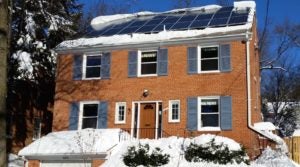What to do about your solar system when storms blow


Solar systems are robust and engineered to work through harsh weather conditions. This includes hail, snow, and high winds. Installers design systems to withstand these conditions and to conform with local building codes.
Before you go solar, you should check with your insurance company to make sure your homeowners insurance covers the panels. A report by the National Renewable Energy Laboratory found that most rooftop solar systems should be covered as part of your standard homeowners policy.
You should contact your insurance company before you install your system to let them know about the addition to your property. Be sure to verify that solar system replacement costs in the event of damage don’t exceed your current policy coverage limits. Adding solar should not increase your homeowner’s insurance premiums. If it does, you may want to find an insurer that provides discounts to customers that “go green”. The report does note that ground-based solar systems may not be covered and may require additional insurance.
Snow will block your panels from working, or severely decrease their production. We don’t recommend that you remove snow from your panels. The panels will heat up and melt the snow from your roof quickly. You shouldn’t worry too much about how this might decrease your system’s performance, as the annual production estimates you were given when you purchase your system assume there will be snowy and rainy days. If your roof is steep you may want to consider installing snow guards with your panels to prevent the snow from sliding off too quickly. This can damage items below the panels.
For a better view of how panels are engineered to withstand the elements, check out this neat video of solar panel stress testing.
